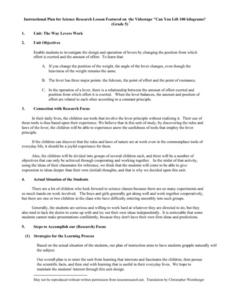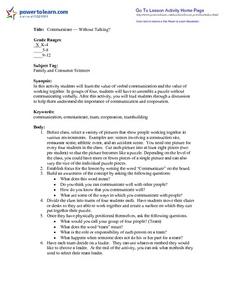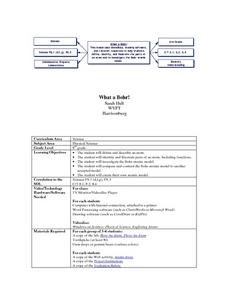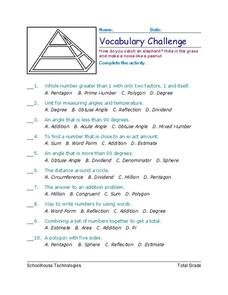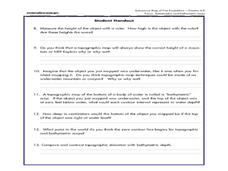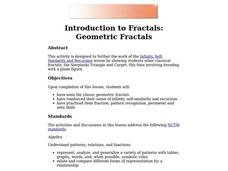Novelinks
The Cure: Guided Imagery
Prepare class members for a discussion of Sonia Levitin's dystopian novel The Cure, by leading them on a guided imagery exercise designed to encourage visualization of written descriptions.
Curated OER
Graphing Ordered Pairs On A Coordinate Plane
Sinking ships, construction paper, coordinate planes, sounds like fun day in math class. Play the game Battleship with your class and reinforce the concept of graphing ordered pairs.
Curated OER
Do the Write Thing
Young scholars take stands on issues that matter to them. In this philanthropy instructional activity, students read Anne Frank: The Diary of a Young Girl, discuss the act of advocating for others, and write letters of support for issues...
Curated OER
Writing Number Sentences
Students practice writing number sentences. After reading real world problems, they describe the same situation by writing a number sentence. Students use algebra tiles, or counters, to demonstrate the use zero pairs in solving...
Curated OER
Charlotte's Web
Fourth graders focus on fluency by reading the book Charlotte's Web. In this reading strategies lesson, 4th graders partner read, do guided reading, and independent reading to increase fluency. Students use Venn Diagrams, discuss...
Curated OER
Ladybugs
Third graders keep and report records of investigations and observations of ladybugs utilizing tools like journals, charts, graphs and computers. They discover and study the life cycle of ladybugs and complete a KWL chart about ladybugs.
Curated OER
The Way Levers Work
Fifth graders discover the rules by which the lever slants and balances. They determine that there are a great many tools that employ the lever principle even in their ordinary environments. They consider how to use objects easily...
Curated OER
Creative Problem Solving
Students respond to a situation presented about the wetlands. In this wetlands activity, students understand the various opinions over the use of areas in the wetlands. Students complete a worksheet using critical thinking questions...
Curated OER
Don't Let Pressure Get to You
Students study the ways peers can pressure them on a daily basis. They watch video segments on how to better deal with peer pressure.
Curated OER
Communicate - Without Talking?
Students discuss and define communication and identify different ways of communicating with people. Students then practice team building and non-verbal communication skills as they work silently in small teams to put puzzles together.
Curated OER
Kids Negotiating the Electronic Superhighway-Self Care & Repetition Injuries
Students arrange, recognize and illustrate the connection of body movements to technology to injury. Students explore their findings to examine the statistics to their own personal lives. Students focus on a variety of resources to...
Curated OER
Let's Make a Meal: A Study of Oats
Students investigate the history and health benefits of oats. In this food history and nutrition lesson, students describe the origin of oats in America, define nutrition related vocabulary, and read and follow recipes for making...
Curated OER
Integrating Chemistry-Chemical Reactions
For this chemical reactions worksheet, students read about different types of chemical reactions, potential and chemical energy. They answer three questions about their reading.
Curated OER
Composition
Ninth graders, while looking and examining a photograph provided to them, write a composition that exemplifies the photograph with at least three of the five composition rules illustrated with 100% accuracy. The composition is the start...
Curated OER
What a Bohr!
Students define, identify and illustrate the parts of an atom, and investigate the Bohr atomic model. Students watch a multimedia presentation to understand an atom's parts and their functions. In groups, they create a model of an atom...
Curated OER
Vocabulary Challenge
In this math vocabulary worksheet, students choose which multiple choice answer best defines twenty-five mathematical terms. Students place their answers on the lines provided.
Curated OER
Improving Elementary Reading Literacy
Young scholars enhance their literary skills through phonemic awareness. In this reading development instructional activity, students read several storybooks and analyze the phonetics, vocabulary, and overall story. The young scholars...
Curated OER
Animals Up!
Young scholars design and build a pedestal or platform that holds a toy animal. In this building activity, students use knowledge from a prior activity as they build a platform or pedestal for a toy animal using on index cards. They...
Curated OER
Slums in the Spotlight: Will the Millennium Development Goals’ Target be Met?
Students examine the conditions of slums in the world. In this critical thinking skills lesson plan, students compare the places that people live in the world as they view scenes from the film "Slumdog Millionaire." Students also...
Curated OER
A Watered-Down Topographic Map
Eighth graders explore the ocean floor. In this topography lesson, 8th graders compare topographical maps to bathymetric charts. They will create a topographic map and note landmarks and other land features.
Curated OER
Anticipatory Set Lesson for First Day of History Class
Students are introduced to the meaning of history and its importance. They examine why societal history plays an essential role in our lives as responsible citizens.
Curated OER
Introduction to Fractals: Geometric Fractals
Students study and observe the patterns made by the areas of the Sierpinski Triangle. Students use the computer to draw two or three iterations to discover the number patterns. Students complete worksheets based on Geometric Fractals.
Curated OER
CREATE A NEW RHYME
Third graders develop basic narratives. They retell a focused story and create a basic publication using available resources (e.g., pictures, colors, computer, copier). They experiment with different forms of creative writing (e.g.,...
Curated OER
The Giving Tree
Fourth graders participate in a shared reading of The Giving Tree. They discuss the relationship between trees and people in the story. Students contribute to a class KWL chart. They create their own KWL chart with at least four things...






